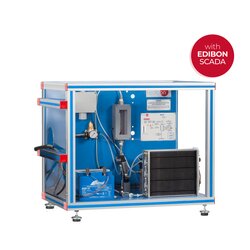Photovoltaic Energy Power Plant (PWP-PE)


PL-911158
The "PWP-PE" Photovoltaic Power Plants by EDIBON provides a platform for studying photovoltaic power plants within the context of microgrids. This application includes a three-phase inverter powered by a photovoltaic panel array simulator, enabling users to explore and configure generation parameters and functions under various scenarios and conditions.
Key learning areas include the study of fundamental concepts in photovoltaic systems, such as Maximum Power Point Tracking (MPPT), inverter power limitations (derating), inverter efficiency, and reactive energy generation. These features allow users to gain insights into the operation and performance optimization of photovoltaic installations.
To enhance real-time analysis, the PWP-PE is equipped with a network analyzer that measures energy production from the photovoltaic power plant, providing critical data for effective microgrid integration and management.
- PWP-PE:
- PSPS/A. Advanced Panel Simulator Power Supply.
- N-INV02. Three-Phase Grid Inverter Module 2.
- N-EALD. Electrical Network Analyzer Module with Oscilloscope and Data Acquisition.
- Cables and Accessories, for normal operation.
- Manuals: This unit is supplied with 8 manuals. Required services, Assembly and Installation, Interface and Control software, Starting-up, Safety, Maintenance, Calibration and Practices manuals.
EXERCISES AND PRACTICAL POSSIBILITIES TO BE DONE WITH THE MAIN ITEMS
Some practical exercises with the included base unit "PWP-PE":
- Installation of photovoltaic power plants.
- Grid-connection of photovoltaic plants.
- Setting the P-V curves for power generation.
- Monitoring the power injection into the grid.
- Maximum power point tracking (MPPT).
- Limiting the inverter power (derating).
- Determining the inverter efficiency.
What is this?
These percentage scores are an average of 0 user reviews. To get more into detail, see each review and comments as per below
If you have used this product, support the community by submitting your review



